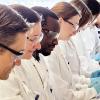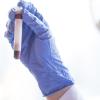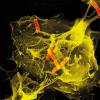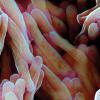Scientists have uncovered a new route for treating infections such as TB, which they hope will lead the way to lessening global reliance on antibiotics.

At the Francis Crick Institute, Max Gutierrez leads the Host-Pathogen Interactions in Tuberculosis Laboratory, a research group that is focused on understanding how Mycobacterium tuberculosis (Mtb, the bacilli that cause the disease) evolve to survive within host cells in the body.
To coincide with World Tuberculosis (TB) Day, which took place on 24 March, the research group published a new study in Nature Microbiology, examining the cellular pathways that could be responsible for tackling this disease.
“I aim to better understand the host cell factors that contribute to Mtb control as well as the Mtb factors that this pathogen uses to hijack host cells. To this end, my lab is developing a variety of cutting-edge imaging technologies in high containment combined with various model systems and approaches at the single cell level”, says Max.
According to estimates from the World Health Organization (WHO), around one quarter of the world’s population is currently infected with tuberculosis bacteria. While only a small proportion of those infected will become sick with TB, people with weakened immune systems have a greater risk of falling seriously ill.
The study reveals the potential in harnessing the power of the body’s natural immune system to treat infections like TB more effectively, thereby lessening reliance on antibiotics. Max adds: “If we understand how cells can kill and restrict bacteria, we can develop therapies that potentially boost these natural responses.”
Observing key cellular pathways in action
In their study, the team took a look at the genes that are central to bacteria’s ability to evade autophagy – a fundamental pathway used by cells to destroy themselves in response to stress.
Researchers at the Crick used human stem cells and reprogrammed them into induced pluripotent stem cells (iPS cells), that are able to develop into any cell type in the body. They then engineered the iPS cells into human immune cells, called macrophages, the main host cell type in humans for Mtb. Genome editing tools were used following this step, to remove genes key to the autophagy process, and the cells were infected with the TB-causing bacilli.

“We were able to have a look at what the real function of these genes is in human macrophages”
“We were able to have a look at what the real function of these genes is in human macrophages, which has been difficult before due to technical bottlenecks that have meant experiments have thus far been limited to animal models.”
As the bacterial infection took hold, the team observed Mtb to replicate more within the engineered macrophage cells, causing mass host cell death. These results point to the significance of the autophagy pathway in restricting Mtb replication in human macrophages. Max says “using the latest technologies, our results show a key role for the [autophagy] pathway in controlling infection.”
Tackling antibiotic resistance
Through their continued focus on understanding how our bodies fight infection via host cell factors, Max and his team have effectively helped to uncover a potential new avenue for treating TB, whilst tackling antibiotic resistance – based on “host-directed therapies”.
While traditional antibiotics act directly on a pathogen, host-directed therapies work to change the local environment in which a pathogen exists to make it less favourable for them to grow.
By boosting the autophagy pathway in macrophages, using either drugs or modulators that affect the host cells and not the bacteria, it would be possible to control infections in a way that is independent of antibiotics.
Max summarises: “As immunotherapies have harnessed the immune system to fight cancer, boosting this immune defence with a host-directed therapy could be a valuable new tool in the fight against infections, particularly those becoming resistant to antibiotics.”
In the case of TB, targeting our own immune systems could be effective because it takes an especially long course of various antibiotic treatments to remove the infection. Beren Aylan, joint first author of the paper, adds: “Anything that can be done to more effectively remove bacteria could also make a huge difference to the cost and accessibility of treatments.”
The team are now looking for ways to boost autophagy in a targeted manner. “Boosting the autophagy pathway isn’t as simple as it might seem. In order to safely increase autophagy in the location of infections, we need to target the pathway in macrophages alone”, says Max. “Our next step is to look for drugs that can specifically stimulate autophagy in macrophages, to see if we can move forward with some of these compounds as host-directed therapies.”
If the team succeeds in their research goals, they may be able to present an altogether new alternative to drugs for treating TB and similar infections.
Fact file: Maximiliano Gutierrez

- 2002 – Qualified from the Universidad Nacional de San Luis, Argentina
- 2006 – Undertook Post-Doctoral Fellowship at the European Molecular Biology Laboratories (EMBL), Germany, focusing on cell biology and imaging of macrophages
- 2009 – Started an independent research group at the Helmholtz Centre for Infection Research in Braunschweig, Germany, as head of the Junior Research Group (“Phagosome Biology”)
- 2012 – Programme Leader Track at the Medical Research Council’s National Institute for Medical Research, London, UK – which then became part of the Francis Crick Institute in 2015
- 2018 – Senior Group Leader at Francis Crick Institute.
Image Credit | SPLibrary




